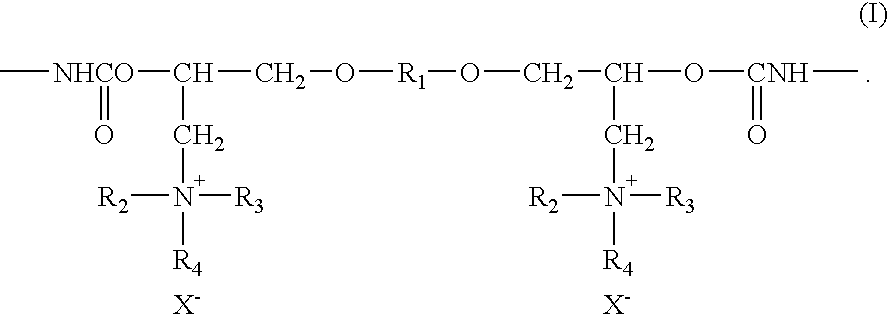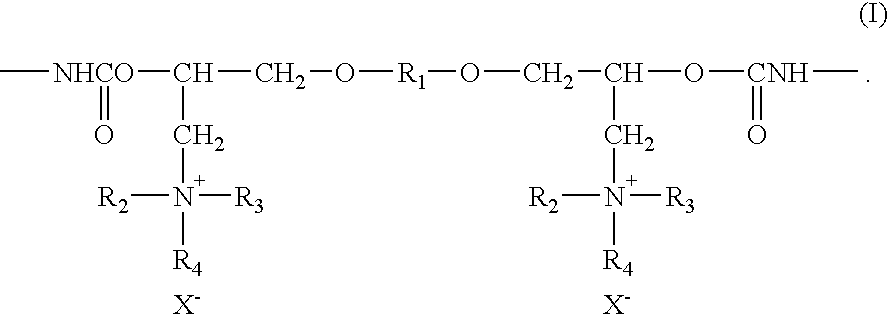Cationic Polyurethane Resin Aqueous Dispersion, Ink-Jet Receiving Agent Including the Same, and Ink-Jet Recording Medium Using the Same
a technology of cationic polyurethane resin and aqueous dispersion, which is applied in the direction of non-metal conductors, conductors, inks, etc., can solve the problems of large viscosity change of dispersion solutions, inability to meet the market requirement level of adhesiveness to an inorganic substrate, and storage stability, etc., to achieve excellent waterproof characteristics and durability of films, excellent adhesiveness, and excellent effect of dispersion
- Summary
- Abstract
- Description
- Claims
- Application Information
AI Technical Summary
Benefits of technology
Problems solved by technology
Method used
Image
Examples
synthesis example 1
Synthesis of Tertiary Amino Group-Containing Polyol (E)-I
[0185] In a four-necked flask equipped with a thermometer, a stirrer, a reflux condenser and a dropping device, 590 parts by mass of polypropylene glycol-diglycidyl ether (epoxy equivalent: 201 g / eq) was added, and then air in the flask was replaced with nitrogen gas. Subsequently, after it was heated using an oil bath until the temperature in the flask increased to 70° C., 380 parts by mass of di-n-butylamine was added drop-wise over 30 minutes, and after addition was completed, the reaction was conducted for 10 hours at 90° C. Then, after the reaction was completed, it was confirmed that the absorption peak in the vicinity of 842 cm−1 had disappeared, wherein the peak represented an epoxy group included in a reaction product, by using an infrared spectrophotometer (FT / IR-460Plus, manufactured by JASCO Corporation), and a tertiary amino group-containing polyol (E)-I (amine equivalent: 339 g / eq, hydroxyl equivalent: 339 g / eq)...
synthesis example 2
Synthesis of Tertiary Amino Group-Containing Polyol (E)-II
[0186] A tertiary amino group-containing polyol (E)-II (amine equivalent: 315 g / eq, hydroxyl equivalent: 315 g / eq) was prepared similar to the Synthesis Example 4 except that 543 parts by mass of polyethylene glycol-diglycidyl ether (epoxy equivalent: 185 g / eq) was used instead of the polypropylene glycol-diglycidyl ether (epoxy equivalent: 201 g / eq).
example 1
[0187] In a four-necked flask equipped with a thermometer, a stirrer, a reflux condenser and a dropping device, 705 parts by mass of NIPPOLLAN 980R (polycarbonate polyol obtained by a reaction between 1,6-hexanediol and dimethyl carbonate, manufactured by Nippon Polyurethane Industry Co., Ltd., hydroxyl equivalent: 986 g / eq) and 352 parts by mass of polyester (hydroxyl equivalent: 951 g / eq), which was obtained by reacting neopentyl glycol, 1,4-butanediol, terephthalic acid and adipic acid, were added, and then, dehydration was conducted under the condition of a decompression degree of 0.095 MPa and temperature of 120 to 130° C.
[0188] After the dehydration, the mixture was cooled at 70° C., and 666 parts by mass of ethyl acetate was added, and then further stirred sufficiently while cooling to 50° C. After stirring was completed, 280 parts by mass of 4,4′-dicyclohexylmethane diisocyanate (4,4-H-MDI) and 0.3 parts by mass of stannous octoate were added to the mixture, and reaction wa...
PUM
| Property | Measurement | Unit |
|---|---|---|
| Fraction | aaaaa | aaaaa |
| Fraction | aaaaa | aaaaa |
| Equivalent per mass | aaaaa | aaaaa |
Abstract
Description
Claims
Application Information
 Login to View More
Login to View More - R&D
- Intellectual Property
- Life Sciences
- Materials
- Tech Scout
- Unparalleled Data Quality
- Higher Quality Content
- 60% Fewer Hallucinations
Browse by: Latest US Patents, China's latest patents, Technical Efficacy Thesaurus, Application Domain, Technology Topic, Popular Technical Reports.
© 2025 PatSnap. All rights reserved.Legal|Privacy policy|Modern Slavery Act Transparency Statement|Sitemap|About US| Contact US: help@patsnap.com



